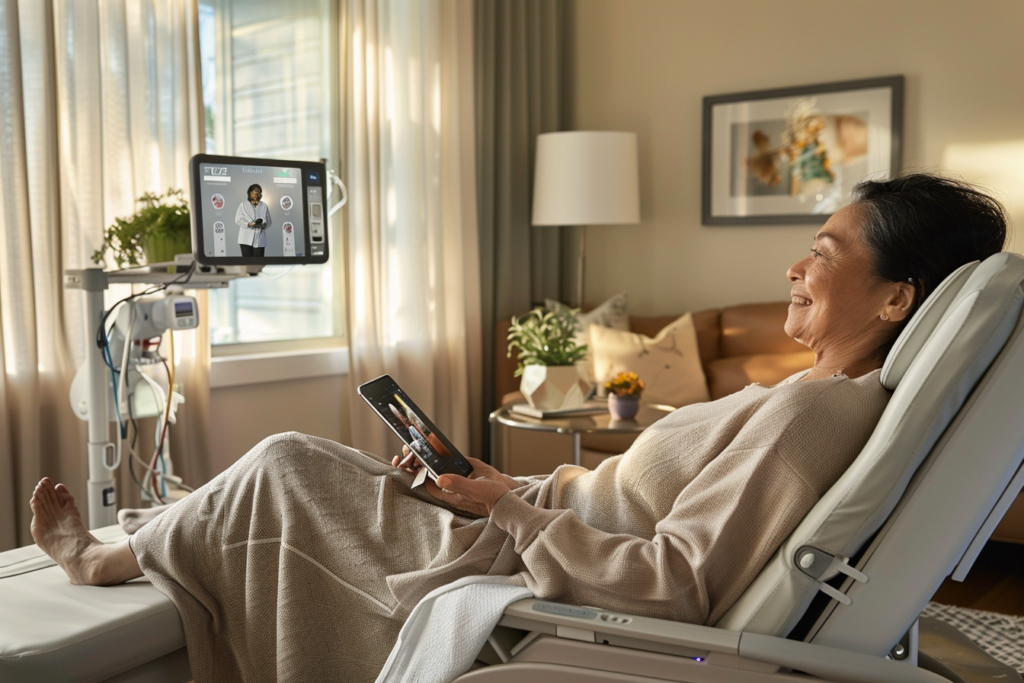The new frontier of healthcare: Bringing hospital care home
This trend is growing because advances in technology and patient preference are driving the hospital-at-home movement.

Like many “new” trends in healthcare, the hospital at home movement is not new. The foundational research goes back nearly 30 years, to work by Bruce Leff, MD, of Johns Hopkins to flesh out the concept of providing acute-level care to patients in their own homes.
It seems to harken back to the notion of doctors carrying black bags into patients’ homes to do house calls, but multiple advances in technologies and trends in healthcare have thrust hospital at home programs to the forefront.
When those pressures converge, change happens. And providing hospital services in the home is gaining new attention.
Provider realities
From the hospital side, several factors are forcing providers to get creative. Census levels are high nationwide, often near full capacity and beyond. Staff rolls are shrinking as growing numbers of clinicians quit because of burnout or unmitigated stress. There’s not enough money to build new brick-and-mortar facilities. And then, lordy, there was the pandemic – many organizations had a crash course in virtual care, forced by restrictions on in-person encounters, full COVID caseloads and nearly instantaneous changes in reimbursement policy that enabled virtual care.
And patients – well, they weren’t big fans of being in the hospital before. The pandemic opened their eyes to the possibility of virtual care, and nascent hospital-at-home programs revealed alternatives to traditional delivery of acute care services.
As one chronic care patient told Leff in his early formulation of a hospital at home strategy, “You run a great hospital, doc, but it’s a lousy hotel.” Factor in the risks of hospital-acquired infections, falls as unsteady patients exit unaccompanied from hospital beds, loneliness and disorientation in a strange clinical environment, harried hands-on caregivers managing multiple patients and … well, it’s clear that an alternative would be welcome.
And inpatient facilities are in no position to fix these ills. Capacity is strained at many hospitals, says Colleen Hole, vice president of clinical integration and chief nurse executive for Atrium Health Medical Group. “Our hospitals are running at 110 percent to 120 percent occupancy in this market,” she says. “And Charlotte is a growing market, and we really can’t afford nor spend the time to keep building brick-and-mortar beds to manage the growth. Money and time are precious, and it doesn’t make sense to keep building beds. But we can deliver hospital-level care in the home and with the same – or in some cases, better – outcomes.”
The COVID pandemic instantly caused hospitals to rethink acute care, because patients seriously affected by the virus were prioritized for inpatient beds. Facilities got creative in many ways, including caring for patients in their homes, supported by patient-monitoring devices, telehealth visits, clinical and ancillary service delivery.
Even so, really going full tilt on a hospital at home program requires a radical mind-shift for hospital administrators, who for decades have equated actual inpatients with hospital revenue. If patients aren’t inside the four walls of an institution, they’re losing that income.
That logic is losing steam as hospitals confront nearly full occupancy, contends Tom Kiesau, chief innovation officer and leader of digital and technology transformation for The Chartis Group. He moderated a HIMSS session fleshing out the growth of a Hospital at Home program at Massachusetts General Brigham. To scale successfully involves more than just having a nurse drive out to patients with some medical supplies in the car. Think of it as “a startup,” he says. “There’s an investment cost upfront before you’re going to demonstrate an ROI. And that’s only half the battle – building the trust and relationships within the brick-and-mortar facility is critical.”
But to build a hospital at home program that has an eventual goal of caring for 50 patients is still cost effective, he adds. For organizations now at constant full capacity, “Your alternative is to build a 50-bed facility, which now has an average cost of $2 million per bed,” he said. “That’s a $100 million facility. With a hospital at home program, there’s less capital involved and a better unit cost on the back end. That’s the value.”

The patient perspective
More than just the dollars, another key component of the value equation are the patients, who are wising up to benefits of getting what was formerly inpatient care in their homes.
Once they learn there’s an alternative to an admission, patients grab at the alternative to a hospital stay, many executives of the programs say.
“Our patients love it, absolutely love,” says Hole of Atrium Health. Just to back that up, the organization has produced an introductory video of patients gushing over the care they get and how they feel about it.
“You know you’re being taken care of, just like you were in the hospital,” says one of Atrium’s Hospital at Home patients. Another notes that, “I’m not much on electronics, but this is unreal,” says another.
Still, raising patient awareness to this option is a major task for providers, overcoming perceptions that hospital inpatients get gold medal care.
“Patients aren’t familiar with this model,” says Heather O’Sullivan, president of healthcare at home for Mass General Brigham, where she oversees its home hospital program. But when they experience acute care services at home, “patients love it and ask for it again. They love the intimacy of care provided in the home.”
Staff solutions?
As hospitals increasingly treat sicker and older patients, hospital at home programs represent a way to offload patient load from nursing staff, better apportioning patients to the most appropriate setting and enabling nurses to focus on the most needy patients.
Offering nurses an alternative to on-the-floor caregiving might attract some to home environments or give them opportunities to provide less physically demanding virtual nursing, contends Oriana Beaudet, vice president of nursing innovation for the American Nurses Association.
Still, the hospital at home program is not widely deployed – for now. And organizations are still figuring out how to grow the initiative.
Even Massachusetts General Brigham has only 40 hospital at home beds available right now, with hopes of nearly doubling that total by the end of the year.
Still, the reimbursement “winds” appear to be pushing the trend ahead, and Chartis’s Kiesau says that nearly 90 percent of respondents to his firm’s 2024 survey “respondents recognize the increasing need for care at home and strongly agree on the urgency to develop a comprehensive approach to remote care in the home.”
That brings them into full agreement with Dorothy in The Wizard of Oz – for many conditions, with the right technology, processes and people – there is no place like home.